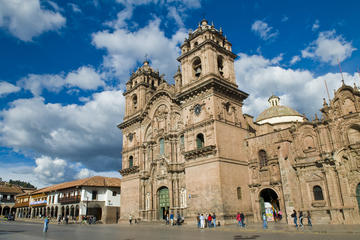
Cusco Historic Center
When it comes to history, few cities in South America are more historic than Cusco. This sprawling city was once the capital of the entire Inca Empire, and many will tell you that ancient Cusco was the grandest city in Peru. Even the name “Cusco” translates as “Navel of the Earth” since the Inca believed the city to be the center of the known world. It pulses with an energy unlike elsewhere in Peru, and there is a palpable magic which permeates these streets set high in the foothills of the Andes.
During the 16th Century, when Spanish conquistadors came marching into Cusco, they kept the structure of the city intact but destroyed many of the buildings. Colonial cathedrals and Spanish architecture took the place of Inca temples, and the city became an Andean fusion of Spanish and Inca design. Given the cultural combination and the grandiose scale of the city, UNESCO declared Cusco as a World Heritage Site in 1983.
When visiting the Cusco Historic Center, begin your tour in the center of town at the fountain-clad Plaza de Armas. This bustling square was the site of many of Cusco’s most historic moments, and the colonial buildings which spring from the square define the charm of Cusco. At the Iglesia Compañia de Jesus, the labyrinths and hidden passages beneath the church house the remains of many conquistadors. On the outside, photograph the building and its ornately-carved entrance which is an iconic image of Cusco.
When leaving the Plaza, meander down streets such as famous
Calle Loreto which still features stonework set in place by the Inca. In addition to the remarkable size of the stones, notice how the blocks fit perfectly together like a jigsaw mosaic of rock.
Once outside of the Plaza, pay a visit to Santo Domingo Church which was built atop sacred ruins. Prior to the arrival of the Spanish, this site was known as Coricancha and was dedicated to the worship of the sun. Since this was the temple for the Inca’s most important deity, the building was flush with statues and altars which were comprised of solid gold. Unsurprisingly, the site was completely looted by the Spanish and a church was erected in its place. Portions of the temple still remain, however, and it’s one of the most culturally-rich sites in the entire Cusco Historic Center.
Other than buildings and architecture, art-lovers can wander the streets of San Blas and peruse the streetside markets. Others can visit the various
paqchas which are ancient sources of water. Or, simply get lost amongst the historic streets and bask in the power of the city. Watch as groups of traditionally-dressed women blend with wide-eyed tourists, and immerse yourself in the mestizo blend in this ancient capital of the Inca.
